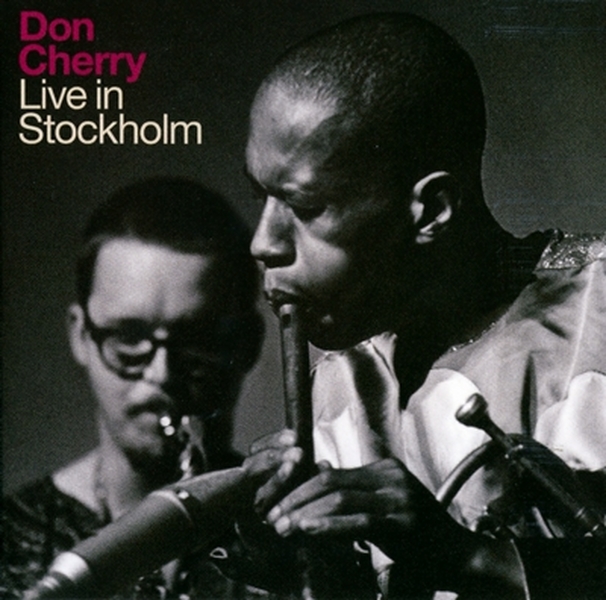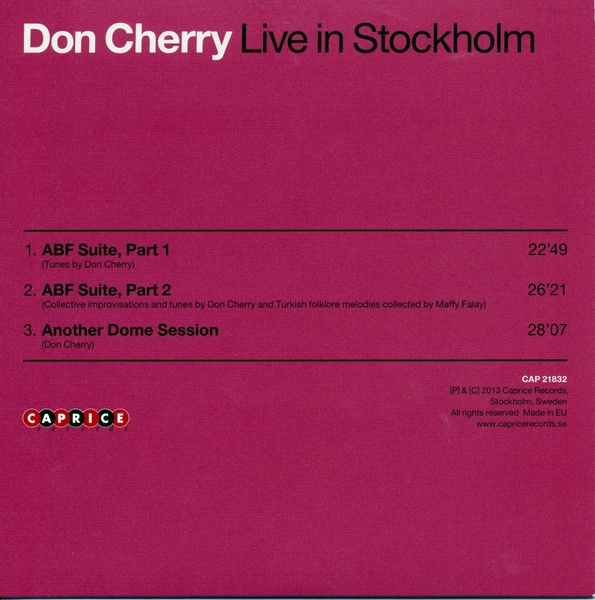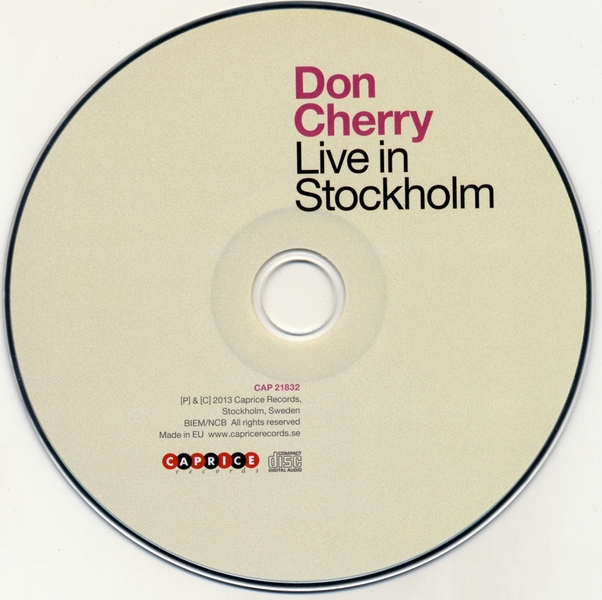


BOOKLET
here is the NFO file from Indietorrents
———————————————————————
Don Cherry – Live In Stockholm
———————————————————————
Artist……………: Don Cherry
Album…………….: Live In Stockholm
Genre…………….: Jazz
Source……………: NMR
Year……………..: 2013
Ripper……………: NMR
Codec…………….: LAME 3.99
Version…………..: MPEG 1 Layer III
Quality…………..: Extreme, (avg. bitrate: 257kbps)
Channels………….: Joint Stereo / 44100 hz
Tags……………..: ID3 v1.1, ID3 v2.3
Information……….:
Ripped by…………: NMR
Posted by…………: blahdebunt on 09/09/2014
News Server……….:
News Group(s)……..:
Included………….: NFO, LOG
Covers……………: Front Back CD
———————————————————————
Tracklisting
———————————————————————
1. Don Cherry – ABF Suite, Part 1 [22:49]
2. Don Cherry – ABF Suite, Part 2 [26:21]
3. Don Cherry – Another Dome Session [28:06]
Playing Time………: 01:17:16
Total Size………..: 142.31 MB
NFO generated on…..: 09/09/2014 23:18:46
:: Generated by Music NFO Builder v1.21b – www.nfobuilder.com ::
Artist: DON CHERRY
Title: LIVE IN STOCKHOLM
Recorded in 1968 (tracks #1 & #2) and 1971 (track #3) by Göran Fresse
Digital transfer from tape: Mats Lundell
Edited by Rune Person & Jan Bruér
Mastering by Jonas André
Liner notes by Thomas Millroth & Jan Bruér
Graphic Design by Jonas André
Executive Producer: Marie Wisén
Release Date: 13 Nov 2013
Total Playing Time: 77:17
Genre: Jazz
Styles: Modern Jazz, Free Jazz, Contemporary Jazz, Free Improvisation
Label: Caprice Records (UCCT-1244)
http://musikverket.se/capricerecords/files/2013/11/CAP_21832_Don_Cherry_Live_in_Stockholm.jpg
***Tracklist:
1. ABF Suite, Part 1 (Tunes by Don Cherry) 22:49
2. ABF Suite, Part 2 (Collective improvisations and tunes by Doherry and Turkish folklore melodies collected by Maffy Falay) 26:21
3. Another Dome Session (Don Cherry) 28:07
***Musicians:
Don Cherry: pocket trumpet, flutes, piano, percussion, vocals
Maffy Falay: trumpet, flutes, percussion
Bernt Rosengren: tenor saxophone, flutes, percussion (tracks 1 & 2)
Tommy Koverhult: tenor saxophone, flutes, percussion (tracks 1 & 2), flute (track 3)
Torbjörn Hultcrantz: bass (tracks 1 & 2)
Leif Wennerström: drums (tracks 1 & 2)
Rolf Olsson (probably): bass (track 3)
Okay Temiz: drums (track 3)
Children and visiting friends (track 3).
***Review from http://www.allaboutjazz.com/:
Don Cherry: Live in Stockholm
By FLORENCE WETZEL, Published: December 19, 2013
Don Cherry: Live in Stockholm
Trumpeter and world-music pioneer Don Cherry had a very special relationship with Sweden, a place he called home for twenty years. And Sweden had a special relationship with Cherry: the country and its musicians recognized the master in their midst, and in 1972 the state-subsidized record company Caprice put out the double album Organic Music Society (which they reissued in 2012). Now with Live in Stockholm, Caprice has gone into its vaults and pulled out three stunning long-form songs from the same era. Beautifully packaged with crisp black-and-white photos and informative liner notes in English, this release offers a full-bodied experience of Cherry’s activities during this fruitful period of his musical journey.
The first two tunes—”ABF Suite, Part 1″ and “ABF Suite, Part 2″—have their origin in the ensemble Cherry created while teaching a weekly course at The Workers’ Educational Association (Arbetarnas Bildningsförbund, or ABF). But this was no ordinary class: his students included the great Swedish tenor saxophonist Bernt Rosengren and members of his quartet, namely fellow tenorist Tommy Koverhult, bassist Torbjorn Hultcrantz, and drummer Leif Wennerström. Another participant was the renowned Turkish trumpeter Maffy Falay, who like Cherry moved to Sweden in the mid-sixties and worked closely with Swedish jazz musicians. In describing the feeling of this ensemble, Rosengren says, “[Don Cherry] came with a new openness. One should not be afraid to break patterns and forms. He came with a completely new way of thinking, we should ‘un-learn’ everything we knew and start again from scratch, and not worry about mistakes . . . It was a very free and experimental period and we had a lot of fun.”
By this point in his career, Cherry had left behind many of the familiar parameters of jazz. For Cherry, a song was not a group of musicians taking solos based on one melody: a song was a fluid entity created on-the-spot, as the ensemble did at the ABF concert. He had also abandoned the “one person, one instrument” norm; he no longer thought of himself solely as a trumpet player, and on this release he is also credited with flutes, piano, percussion, and vocals. Similarly Falay, Rosengren, and Koverhult are also credited with flutes and percussion in addition to their main instruments. Nor was a concert visually static—in collaboration with his wife, visual artist Moki Cherry, Cherry turned the ABF concert into a multimedia happening with elaborate staging, including wafting incense and a background of screens and projections of paintings by Moki.
The festive quality of the concert is reflected in a review by the Swedish newspaper Dagens Nyheter, which proclaimed: “Welcome to Don Cherry’s candy store of music! What richness, colors, generosity!” A candy store is a good way to think of these two pieces, which offer a luscious 49 minutes of music. There’s a myriad of flavors and sensations, a dancing flow of energy as the stream of ideas and sounds unfold. Different players with different instruments take center stage, following an organic, internal logic specific to this performance. Distinct melodies emerge, but just in slices, which are then fused together, or taken apart, or cheerfully turned inside out. Various motifs arise, perhaps to be picked up by the other musicians, who might then approach things sideways or backward. The dynamics are also up for grabs, a wild thrust of energy suddenly or gradually dropping off into a quieter space, until eventually the silence explodes into a torrent of sound. The mood is a similarly shape-shifting creature, moving from calm to stately to frantic to joyful, and many other hues besides.
Part of the pleasure of this music is that one never knows what’s coming next: singing, percussive accents, empty space, flutes like birds, snaking sax lines, even a majestic interlude that conjures up Miles Davis’s Sketches of Spain. And it’s not always possible to know who’s playing what, but in an ensemble like this where energies merge and no one is top dog, individual voices are not the main point. This combination of American, Swedish, and Turkish musicians is an international incident in the best sense of the term: it’s a joyful joining of diverse musical worlds and cultures, showing how they can combine into something unified and exciting. The entire concert is fueled by a propulsive, wild-hearted energy that’s consistently compelling, offering an excellent example of the fine art of group improvisation.
The third piece comes from a concert that Cherry gave at Stockholm’s Moderna Museet (Museum of Modern Art), an institution known for welcoming avant-garde creativity in all forms. Cherry’s concert was part of an exhibition called “Utopia and Vision,” and the concert took place in the geodesic dome built by the far-seeing American architect Buckminster Fuller. Just as with the ABF concert, Cherry entered a unique space that brought forth a one-of-a-kind musical organism. A photo of Cherry playing percussion in the dome gives a sense of this special atmosphere: the floor and curving walls are a bright, luminous white, pure and otherworldly as a spaceship. Another important aspect of the concert was the audience participation; the credits include “children and visiting friends,” and the dome photo shows Cherry’s son Eagle-Eye (a musician himself, and brother of the radiant Neneh Cherry), who is standing next to his father and utterly transfixed by the moving mallets in his father’s circle of percussion.
The dome concert has a slightly different configuration from the ABF performance. Cherry, Falay, and Koverhult return, but this time with Swedish bassist Rolf Olsson and the great Turkish drummer Okay Temiz. Temiz provides a different kind of rhythmic foundation, and the song often has a spacious, dreamy feel. Like the ABF concert, this 28 minutes of music travels many distances, including a majestic Cherry solo in a shimmering field of percussion with looping whistles and random voices. Children’s voices weave in on occasion, and since Koverhult only plays flute, the instrument has a more prominent role and adds a lofty, transcendent feel. Cherry switches to piano about a third of the way through, creating buoyant lines reminiscent of Vince Guaraldi’s classic Charlie Brown soundtracks. The music gradually enters a more contemplative space, with the instruments intertwining in a beautiful, almost mournful tone. This eventually gives way to an intoxicating, escalating energy, which builds to a powerful crescendo incited by Cherry’s forceful piano chords. Cherry’s vocals ride along the growing energy, a host of primal utterances that float and dance, incite and rouse. In the song’s coda, the instruments and vocals drop off, and Cherry’s piano motif fades off into the silence of the incandescent white dome.
Don Cherry was a citizen of the world, and the wonderful international groups on Live in Stockholm present aural bouquets from Cherry’s multicultural musical landscape. Best of all, these three songs are a shining example of holy playfulness. Amid the rule breaking and mischief making, each piece is infused with a sense of music as sacred activity. These four-dimensional sonic sculptures are praise songs; they create an atmosphere of celebration that explores and brings forth an open, joyful creativity that’s infused with a sense of equality. These tunes are a reminder of what humanity is capable of, and an example of the aspiration to work together instead of tearing one another apart. This fine release is permeated with a spirit of harmony, offering a message that’s still extremely welcome today.
Track Listing: ABF Suite, Part 1; ABF Suite, Part 2; Another Dome Session.
Personnel: Don Cherry: pocket trumpet, flutes, piano, percussion, vocals; Maffy Falay: trumpet, flutes, percussion; Bernt Rosengren: tenor saxophone, flutes, percussion (tracks 1 & 2); Tommy Koverhult: tenor saxophone, flutes, percussion (tracks 1 & 2), flute (track 3); Torbjörn Hultcrantz: bass (tracks 1 & 2); Leif Wennerström: drums (tracks 1 & 2); Rolf Olsson (probably): bass (track 3); Okay Temiz: drums (track 3); Children and visiting friends (track 3).
Record Label: Caprice Records
Style: Modern Jazz
***Review from http://www.theguardian.com/:
Don Cherry: Live in Stockholm – review
(Caprice)
3 stars out of 5
John Fordham
theguardian.com, Thursday 2 January 2014
These are previously unissued live recordings from 1968 and 1971, catching that world-musical gypsy Don Cherry with Swedish and Turkish musicians in his adopted Scandinavia. In three long, partially improvised sets with partners including the fine Stockholm saxophonist Bernt Rosengren and Istanbul drummer Okay Temiz, the former Ornette Coleman partner participates as a receptive equal, and plays percussion, flutes and piano as well as pocket trumpet. The 1960s free jazz of Coleman and John Coltrane inevitably influences this often loosely clamorous ensemble music, but startling composed parts frequently rise amid the swirl – like the mischievously Ornette-like melody that forms five minutes into the opening ABF Suite Part 1, and the jaunty Turkish folk themes (supplied by fellow trumpeter Maffy Falay) that pepper Part 2. The 1971 recording, the loosest of the three, was made in Buckminster Fuller’s Geodesic Dome at Stockholm’s Museum of Modern Art, and that era’s expressionistic optimism and faith in intuition imbue all of this warm, soulful, and sketchily conceived music. As art historian and Cherry fan Thomas Millroth writes in the liner notes: “Politics were possibilities, and the future not only existed but belonged to us.”
***Review from http://www.freejazzblog.org/:
Don Cherry – Live In Stockholm (Caprice, 2013) ***½
By Stef
Some years ago, I wrote this review on Don Cherry tribute albums, but now we have access again to one of the great performances of the visionary artist.
The music on the double LP has not been previously released, and we can thank the label for releasing this great addition to Cherry’s discography, although I think that some bootleg versions of this performance already circulated, although with less good quality, even if the sound quality here is not superb either.
The performances were recorded in Sweden, in the the Arbetarnas Bildningsförbund (abbreviated ABF and translated as Workers’ Educational Association), which explains the titles “ABF Suite : Part 1” and “ABF Suite : Part 2”. The band on these tracks consists of Cherry himself on pocket trumpet, flutes, piano, percussion and vocals, Maffy Falay on trumpet, flutes and percussion, Bernt Rosengren on tenor saxophone, flutes and percussion, Tommy Koverhult on tenor saxophone, flutes and percussion, Torbjörn Hultcrantz on bass, Leif Wennerström on drums. The performance dates from September 1968.
The third track was performed three years later in the Bucky Dome, at the Museum of Modern Art, and is called “Another Dome Session”, split in two parts. Apart from Don Cherry and Maffy Falay, the band consists of Tommy Koverhult on sax, Rolf Olsson on bass, Okay Temiz on drums, accompanied by “children and visiting friends”.
It is maybe this last element which made Don Cherry who he was. A true citizen of the world, he wanted to celebrate life and music in all its variety and spontaneous joy. Technical skill in this vision did not appear to be a prerequisite for good music, as long at this spontaneous celebration was part of it. Cherry’s approach to music was obviously strongly influenced by Ornette Coleman, with whom he performed for many years in the famous quartet, but he took a different direction as a leader. Yes, like Coleman, he kept to the melody, or a sequence of melodies as the backbone for improvisations, instead of harmonic progressions and the more traditional theme-improv-theme structure. The few chore phrases were known and rehearsed by the musicians, but could be played at any time and in any sequence during the improvisations, bringing the band back together after sometimes wonderful excursions into world jazz territory, or equally often into meandering bifurcations of little interest or dynamics.
I leave it up to the listener to judge which is which, yet the end result is always fun, and it is really hard for me as a fan to be negative about this. It is such a joy to hear his music, and the all-inclusive approach, that even the lesser moments are taken without regret and even with feelings of generosity.
The album also gives a great perspective on how his music evolved over the years. The ABF suite is still close to the idea of his album “Complete Communion”, released in 1966, with some of the themes of that album figuring as part of the suites. On the Dome performance, the playing is already beyond jazz, with lots of singing, flute playing, middele-eastern percussion, and strange evolutions of loose lack of activity, which can make us wonder what actually happened on stage at that moment, but then out of this quiet indecisiveness arises the most beautiful trumpet theme, one that will be repeated years later with Codona, ending again in a great warm blanket of common improvisation and singing.
Don Cherry was unique, for sure, a wonderful artist, someone whose music always projects great feelings, authentic feelings for humanity and life, a music that is both sacred and tribal, while at the same time trying to be accessible for all to listen to, and equally for all to join in, and play, and even dance on stage, or just at home, while listening.
This is not his best album, but fans of the artist should not miss this one, and it will in any case lift everyone’s spirits. Guaranteed!
